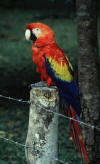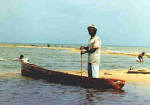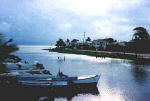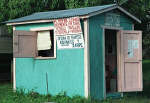|
![]()
Mérida in the Yucatán, Mexico, early morning. I farewelled my travel companion Chrissy who was flying back to Australia. Next I boarded a bus going south to Chetumal on the border with Belize.
I had allowed a month to get to Panama City where I would catch my plane to Jo’burg, South Africa. This seemed a reasonable time frame and a nice challenge. First priority was to arrive in one piece with all belongings. Anything else would be a bonus!
My big worry was the Gulf of Honduras. How to bridge the gap from Belize to Honduras because there are no roads? Only small boats take a few passengers across now and then. I’ve never liked small boats but enjoy travelling on big ones, preferably 5000 tonnes upwards.
Through Belize
|
![]()
From Chetumal I caught the 9:45 am Batty Bus to Belize City. It stopped briefly at Corozal and Orange Walk, arriving at Belize City 2:30 pm. They had no bus going further south but suggested going to the Z-line terminal several blocks away. Not wanting to stay overnight, I hurtled around to this terminal and climbed aboard the 3 pm Z-Line bus to Dandriga, a southern river port and my first hope of getting across the Gulf.
The countryside? It’s flat with sugar plantations, some coconut and banana palms. Trucks ply the road piled high with cane for the mills. Nearer Dandriga there is much citrus. We stopped at Gales Point, a coastal resort which, like most Belize towns, consists of ramshackle wooden houses about to fall down or be blown away by the next hurricane. It is peculiar seeing notices in English and road signs in miles in Central America, a consequence of this once being the colony of British Honduras.
At Dandriga I booked into the Riverside Hotel, conveniently located above a minimarket and close to where the boats are moored. Yes, there was a boat (lancha) going to Honduras tomorrow morning! The lady at the booking office took my passport (to get an exit stamp) and I paid US$50 for the fare. “Be here by 9 o’clock in the morning,” she said.
I awoke to the sounds of chickens and geese squawking. The boat was due to go at 9 or 9:30 am to catch the tide. There were two English girls and an American guy who smoked a cigar impatiently along with local dark-haired Hondurans; in all 12 passengers with gear and rucksacks to be stowed away. The weather was threatening, dull and overcast with a drizzle setting in.
|
![]()
I inspected our boat, a typical Belizean skiff, having two 150 Yamaha outboard motors, with seats either side and a covered area at the bow to store all the gear. It was not until 11 am that we climbed aboard and donned our lifejackets. The captain and two deck hands (although there was no deck) did not bother with lifejackets … typical boaties!
Off We Go
|
![]()
We cruised sedately down river under the bridge and headed for the river mouth waving goodbye to an old guy standing up in a dugout canoe. Then we came to an abrupt halt in a foot of water! The tide was on its way out. Everybody out. Small boys came splashing over to give us a push. After much heaving for 50 meters we passed into deeper water and gathered speed.
We headed SSE towards the barrier reef some 25 kms distant. Top speed was about 40 kms/hour which meant that everyone got drenched from spray and what with periodic tropical downpours, we quickly became a boatload of drowned rats! Now and then we passed palm-studded islands, part of the reef. Very interesting (on a fine day!). It was difficult to see anything in the driving rain with a plastic garbage bag over my head with one hole to peer out of and huddled down behind the next passenger.
Pirate’s Island
After two hours of high speed cruising we pulled in to leeward of a tiny atoll, called Pumpkin Caye, where there lived a Frenchman in a house on stilts. There were about 100 coconut palms, much coral and conch shells, and in the lagoon pelicans swooped down to dive on fish. Here the crew refueled the motors with gasoline from drums. The captain fraternized with the Frenchman and we all had a cup of tea in the shelter underneath the house.
Radio contact was made with civilization. It was still blowing a gale with periodic driving rain. We waited two hours for the weather to improve. It didn’t much. At 3 pm the captain decided to take off again for Puerto Cortes.
“Only a 1½ hour run”, he informed us. “Have to go now to get there before dark! ”
“Christ,” I thought, I was half hoping we would stay overnight on the island, even standing up on terra firma would be OK with me!
Soon the tiny island and the barrier reef was left far behind and we roared along heading across the deep water of the Gulf towards Honduras. The swell got bigger and bigger reaching 2 to 3 meters with white caps breaking. The captain was standing up amidships at the wheel and the other two crew sat at the back by the motors. He steered the boat skillfully in the heaving seas.
|
![]()
The garbage bag protected me somewhat and I kept my eyes shut, except to glance at my watch. Another 5 minutes gone … only another 50 minutes … another 40 minutes. Then I would check my pocket compass… yes, we were going SSE … we can’t really miss Honduras, provided we keep on going.
Man Overboard!
Suddenly we bounced heavily off a wave and there was a yell. “Hey!” the motors died and I looked out. One of the crew had gone overboard! Silly bugger. No lifejacket! He thought it was a great joke. If both crew had gone overboard we wouldn’t have noticed and they would have been goners.
The captain circled the boat in the high seas and we dragged him aboard. Off we went again in dimming light. By 4:45 pm I was overjoyed to see a light or two ahead. We are going to make it! More lights. Must be an oil refinery. The swell lessened and we roared at top speed into the harbour as if nothing had happened.
“We’ve never lost anybody yet!” declared the captain. It must have been just a normal crossing – but not for me!
Welcome to Honduras and Puerto Cortes
I headed for the Hotel Formosa and spent two days drying everything out! Next move San Pedro Sula and the capital, Tegucigalpa. Here I come!
The Gulf of Honduras is part of the Caribbean Sea and is bordered by Belize, Guatemala and Honduras. There are no roads that connect these countries on the Caribbean Coast.
Small boat crossing points are:
For Guatemalan destinations check with Requena’s Charter Services (daily to Puerto Barrios). Boat operators come and go and some services are 2 or 3 times per week, hence it is necessary to arrive on the scene and enquire what offers. Also, consult Lonely Planet Guide for Central America. For bus transport in Belize consult bus schedules.
Dandriga
River port ca 170 kms south of Belize City; population 9,000. Accommodation: See Lonely Planet Guide. Recommended for location and security is Riverside Hotel at US$11 per person.
Punta Gorda (or PG)
Coastal settlement ca 339 kms south of Belize City; population 3500; also the end of the road in southern Belize.
|
Accommodation: Popular with travellers is Nature’s Way Guest House at US$10 per person. The boat crossing to Puerto Barrios in Guatemala is a convenient way to get to the famous Copán Ruins located just across the border in Honduras. Take the bus to Chiquimula then head for the Copán border crossing.
Cautions
Boat Travel:
Always you get wet. Buy a roll of plastic garbage bags and share them with your fellow travellers. Use smaller plastic bags to keep dry your valuables e.g., passport, money, papers, cameras, cigarettes, matches etc.
Maintain a good supply of US dollar notes in low denominations when crossing borders, because always they are acceptable currency, whereas the local currencies may only be changeable at the border, if you are lucky.
Land Travel:
You don’t always get robbed but you will be if you travel in a daydream unaware of the dangers. Widespread poverty and unemployment in Central American countries makes the backpacker seem like a walking gold mine to the locals, especially in the towns and cities.
Avoid putting yourself and gear in a vulnerable position vis-a-vis the sneak thieves (often children), pickpockets, muggers and robber gangs.
Good luck and buen viaje!
Tourism
Belize is renowned for its barrier reef and associated diving resorts, also mountain lodges in the tropical jungle frequented by well-heeled naturalists and bird watching enthusiasts, usually in tour groups. Upmarket tourism is well developed and safe. However the DIY budget traveller needs to proceed with caution.
Climate
Coastal regions are sub-tropical with trade winds from the Caribbean Sea. Warm, humid and wet. Most rain falls June to December. Hurricane months are August and September. Check weather today for Belize City and Puerto Cortes.
Currencies
One US dollar equals 2 Belize dollars (fixed); or 14.8 Lempira (Honduras), or
8.0 Quetzal (Guatemala), but check the rates today.
The Author

You can visit Allano’s web site by clicking here.





